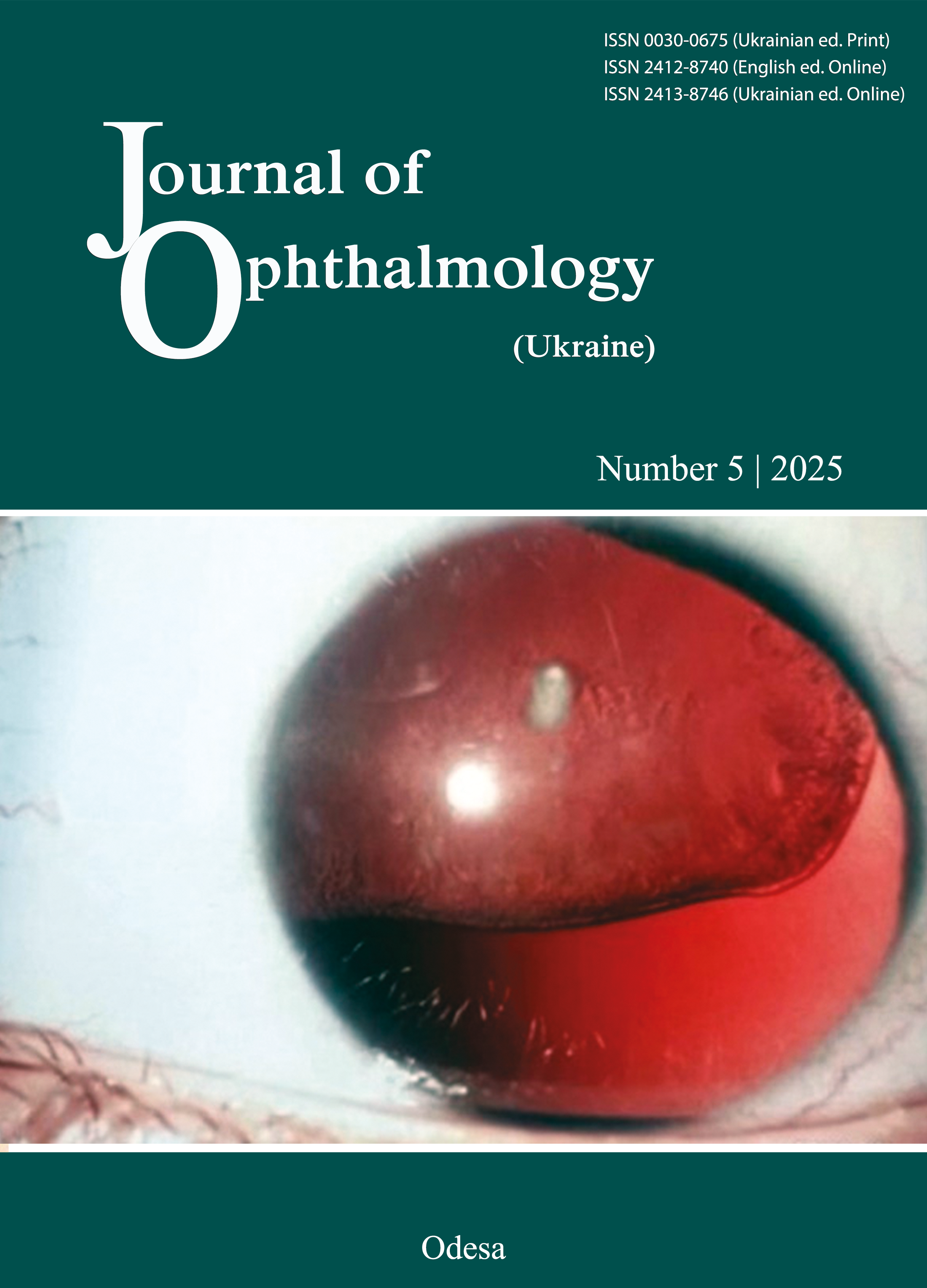Особливості біоелектричної активності сітківки парного ока у хворих на регматогенне відшарування сітківки, асоційоване з відшаруванням судинної оболонки
DOI:
https://doi.org/10.31288/oftalmolzh202554452Ключові слова:
сітківка, судинна оболонка, відшарування сітківки, відшарування судинної оболонки, електроретинографія, патологічна міопія, дегенерація сітківкиАнотація
Мета. Визначити за даними ганц-фельд електроретинографії (ЕРГ) особливості біоелектричної активності сітківки на парному оці хворих на неускладнене регматогенне відшарування сітківки (РВС) та РВС, асоційоване з відшаруванням судинної оболонки (РВС+ВСО).
Матеріал та методи. Обстежено 52 парних ока пацієнтів через три місяці після хірургічного лікування РВС: 32 ока з неускладненим РВС та 20 очей з РВС+ВСО. Контрольну групу склали 14 осіб (28 очей). Усі пацієнти мали міопію середнього або високого ступеня. Проведено офтальмологічне обстеження і повнопольову ЕРГ відповідно до стандартів ISCEV.
Результати. На амплітуду хвилі «b» скотопічної 0,01 ЕРГ впливали фактор ступеню міопії (F=3,83, р=0,01) та фактор наявності ВСО на хворому оці (F=5,0 р=0,03). На амплітуду хвилі «b» скотопічної комбінованої 3 ЕРГ впливали фактор ступеню міопії (F=4,65 р=0,012) та фактор наявності на хворому оці ВСО (F=9,18 р=0,005).
У групі РВС+ВСО фотопічна ЕРГ (активність центральної сітківки) показала подовження часу хвилі «а» на 14% (р=0,005), хвилі «b» на 12,3% (р<0,05), ніж в контролі. На час хвилі «а» фотопічної 3 ЕРГ впливає фактор наявності ВСО (F=10,2 р=0,003): при високій міопії на парному оці при РВС+ВСО цей час довше на 19% (р=0,05), ніж у пацієнтів без ВСО. Визначено вплив фактора міопії на амплітуду хвилі «b» фотопічної 3 ЕРГ (F=3,02 р=0,042). При високій міопії на парному оці амплітуда хвилі «b» була знижена відносно контролю на 32,5% (р=0,01) при РВС та на 40% (р=0,005) при РВС+ВСО. Відносно контролю амплітуда хвилі «b» на парному оці при високій міопії знижена на 32,5% при РВС та 40% при РВС+ВСО (р<0,01).
Висновок. Виявлено суттєві відмінності у біоелектричній активності периферичної сітківки як шару фоторецепторів (паличок), так і середніх (біполяри) шарів сітківки на парному оці у хворих на РВС+ВСО, порівняно з даними при неускладненому РВС. За даними проведеного дослідження парного ока хворих с однаковим ступенем міопії на обох очах можна припустити, що ВСО при РВС розвивається у хворих з більш вираженими порушеннями показників ЕРГ.
Посилання
Sharma T, Challa JK, Ravishankar KV, Murugesan R. Scleral buckling for retinal detachment. Predictors for anatomic failure. Retina. 1994;14(4):338-43. https://doi.org/10.1097/00006982-199414040-00008
Burton TC. Preoperative factors influencing anatomic success rates following retinal detachment surgery. Transact Sec Ophthalmol Am Acad Ophthalmol Otolaryngol. 1977;83(3 Pt 1):OP499-505.
De Smedt S, Sullivan P. Massive choroidal detachment masking overlying primary rhegmatogenous retinal detach¬ment: a case series. Bull Soc Belge Ophtalmol. 2001; 282: 51-55.
Girard P, Mimoun G, Karpouzas I, Montefiore G. Clinical risk factors for proliferative vitreoretinopathy after retinal detachment surgery. Retina. 1994; 14: 417-424.https://doi.org/10.1097/00006982-199414050-00005
Li Z, Li Y, Huang X, Cai XY, Chen X, Li S, Huang Y, Lu L. Quantitative analysis of rhegmatogenous retinal detachment associated with choroidal detachment in Chinese using UBM. Retina. 2012;32(10):2020-5.https://doi.org/10.1097/IAE.0b013e3182561f7c
Kang JH, Park KA, Shin WJ, Kang SW. Macular hole as a risk factor of choroidal detachment in rhegmatogenous retinal detachment. Korean J Ophthalmol. 2008;22(2):100-3.https://doi.org/10.3341/kjo.2008.22.2.100
Wei Y, Wang N, Chen F, et al. Vitrectomy combined with periocular/intravitreal injection of steroids for rhegmatogenous retinal detachment associated with choroidal detachment. Retina. 2014; 34(1): 136-14.https://doi.org/10.1097/IAE.0b013e3182923463
Alibet Y, Levystka G, Umanets N, Pasyechnikova N, Henrich PB. Ciliary body thiсkness changes after preoperative anti-inflammatory treatment in rhegmatogenous retinal detachment complicated by choroidal detachment. Graefe's Arch. Clin. Exp. Ophthalmol. 2017. 255(8): 1503-1508.https://doi.org/10.1007/s00417-017-3673-2
Seelenfreund MH, Kraushar MF, Schepens CL, Freilich DB. Choroidal detachment associated with primary retinal detachment. Arch Ophthalmol. 1974;91(4):254-8.https://doi.org/10.1001/archopht.1974.03900060264003
Rahman N, Harris GS. Choroidal detachment associated with retinal detachment as a presenting finding. Can J Ophthalmol. 1992;27(5):245-8.
Yu Y, An M, Mo B et al. Risk factors for choroidal detachment following rhegmatogenous retinal detachment in a chinese population. BMC Ophthalmol. 2016; 16: 140. https://doi.org/10.1186/s12886-016-0319-9
Wong YL, Ding Y, Sabanayagam C et al. Longi¬tudinal changes in disc and retinal lesions among highly myopic adolescents in Singapore Over a 10-Year period. Eye Contact Lens. 2018; 44:286-291.https://doi.org/10.1097/ICL.0000000000000466
Zahra S, Murphy MJ, Crewther ShG, Riddell N. Flash Electroretinography as a Measure of Retinal Function in Myopia and Hyperopia: A Systematic Review. Vision (Basel). 2023 Feb 27;7(1):15. https://doi.org/10.3390/vision7010015
Gupta SK, Chakraborty R, VerkicharlaPK. Electroretinogram responses in myopia: a review. Doc Ophthalmol. 2021 Nov 17;145(2):77-95.https://doi.org/10.1007/s10633-021-09857-5
Sun J, Zhou J, Zhao P, et al. High prevalence of myopia and high myopia in 5060 Chinese university students in Shanghai. Invest. Ophthalmol. Vis. Sci. 2012; 53: 7504-7509.https://doi.org/10.1167/iovs.11-8343
Purves D, Augustine GJ, Fitzpatrick D et al. Vision: the eye. In: Purves D, Augustine GJ, Fitzpatrick D et al (eds) Neuroscience, 3rd edn. Sinauer Associates Inc, Sunderland, Massachusetts (USA), 2004. pp 229-257.
Quinn N, Csincsik L, Flynn E et al. The clinical relevance of visualising the peripheral retina. Prog Retin Eye Res. 2019; 68:83-109.https://doi.org/10.1016/j.preteyeres.2018.10.001
Robson AG, Nilsson J, Li S et al. ISCEV guide to visual electrodiagnostic procedures. Doc Ophthalmol 2018; 136:1-26.https://doi.org/10.1007/s10633-017-9621-y
McCulloch DL, Marmor MF, Brigell MG et al. ISCEV Standard for full-field clinical electroretinography (2015 update). Doc Ophthalmol. 2015. 130:1-12.https://doi.org/10.1007/s10633-014-9473-7
Frishman LJ. Origins of the electroretinogram. In: Heckenlively JR, Arden GB (eds). Principles and practice of clinical electrophysiology of vision, 2nd edn. The MIT Press, Cambridge, MA, 2006. pp 139-183.https://doi.org/10.7551/mitpress/5557.003.0019
Perlman I. The Electroretinogram: ERG. In: Kolb H, Fernandez E, Nelson R (eds) Webvision: the organi¬zation of the retina and visual system. University of Utah Health Sciences Center, Salt Lake City (UT), 2020. pp 1371-1412.
Robson AG, Frishman LJ, Grigg J, Hamilton R, Jeffrey BG, Kondo M, Li S, McCulloch DL. ISCEV Standard for full-field clinical electroretinography (2022 update). Doc Ophthalmol. 2022 Jun;144(3):165-177. https://doi.org/10.1007/s10633-022-09872-0
Wu De Zheng, Liu Yan. Atlas of testing and clinical application for Roland Electrophysiological Instrument. BeijingScience and TechnologyPress, 2006. р.5-19.
Flitcroft DI, Adams GG, Robson AG et al. Retinal dysfunction and refractive errors: electrophysiological study of children. Br J Ophthalmol. 2005. 89: 484-488].https://doi.org/10.1136/bjo.2004.045328
Marmor MF, Fulton AB, Holder GE, Miyake Y, Brigell M, Bach M. ISCEV Standard for full-field clinical electroretinography (2008 update). Doc Ophthalmol (2009) 118:69-77. https://doi.org/10.1007/s10633-008-9155-4
Westall CA, Dhaliwal HS, Panton CM et al. Values of electroretinogram responses according to axial length. Doc Ophthalmol. 2001; 102:115-130. https://doi.org/10.1023/A:1017535207481
Koh V, Tan C, Nah G et al. Correlation of structural and electrophysiological changes in the retina of young high myopes. Ophthalmic Physiol Opt. 2014; 34:658-666.https://doi.org/10.1111/opo.12159
Kader MA. Electrophysiological study of myopia. Saudi J Ophthalmol. 2012; 26:91-99.https://doi.org/10.1016/j.sjopt.2011.08.002
Perlman I, Meyer E, Haim T et al. Retinal function in high refractive error assessed electroretinographically. Br J Ophthalmol. 1984; 68:79-84.https://doi.org/10.1136/bjo.68.2.79
Wang P, Xiao X, Huang L et al. Cone-rod dysfunction is a sign of early-onset high myopia. Optom Vis Sci. 2013; 90:1327-1330.https://doi.org/10.1097/OPX.0000000000000072
Ishikawa M, Miyake Y, Shiroyama N. Focal mac¬ular electroretinogram in high myopia. Nippon Ganka Gakkai Zasshi. 1990; 94:1040-1047.
Blach RK, Jay B, Kolb H. Electrical activity of the eye in high myopia. Brit J Ophthalmol. 1966; 50:629-641.https://doi.org/10.1136/bjo.50.11.629
Khramenko NI, Umanets MM, Rozanova ZA, Levytska GV. Ocular hemodynamics in patients with rhegmatogenous retinal detachment complicated by choroidal detachment. J of Ophthalmol (Ukraine). 2021; 5: 28-34.https://doi.org/10.31288/oftalmolzh202152834
##submission.downloads##
Опубліковано
Як цитувати
Номер
Розділ
Ліцензія
Авторське право (c) 2025 Левицька Г. В., Храменко Н. І.

Ця робота ліцензується відповідно до Creative Commons Attribution 4.0 International License.
Ця робота ліцензується відповідно до ліцензії Creative Commons Attribution 4.0 International (CC BY). Ця ліцензія дозволяє повторно використовувати, поширювати, переробляти, адаптувати та будувати на основі матеріалу на будь-якому носії або в будь-якому форматі за умови обов'язкового посилання на авторів робіт і первинну публікацію у цьому журналі. Ліцензія дозволяє комерційне використання.
ПОЛОЖЕННЯ ПРО АВТОРСЬКІ ПРАВА
Автори, які подають матеріали до цього журналу, погоджуються з наступними положеннями:
- Автори отримують право на авторство своєї роботи одразу після її публікації та назавжди зберігають це право за собою без жодних обмежень.
- Дата початку дії авторського права на статтю відповідає даті публікації випуску, до якого вона включена.
ПОЛІТИКА ДЕПОНУВАННЯ
- Редакція журналу заохочує розміщення авторами рукопису статті в мережі Інтернет (наприклад, у сховищах установ або на особистих веб-сайтах), оскільки це сприяє виникненню продуктивної наукової дискусії та позитивно позначається на оперативності і динаміці цитування.
- Автори мають право укладати самостійні додаткові угоди щодо неексклюзивного розповсюдження статті у тому вигляді, в якому вона була опублікована цим журналом за умови збереження посилання на первинну публікацію у цьому журналі.
- Дозволяється самоархівування постпринтів (версій рукописів, схвалених до друку в процесі рецензування) під час їх редакційного опрацювання або опублікованих видавцем PDF-версій.
- Самоархівування препринтів (версій рукописів до рецензування) не дозволяється.












